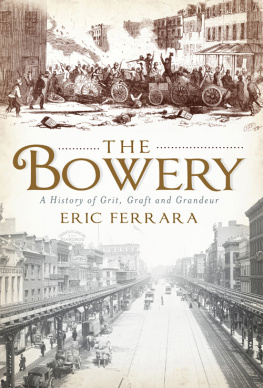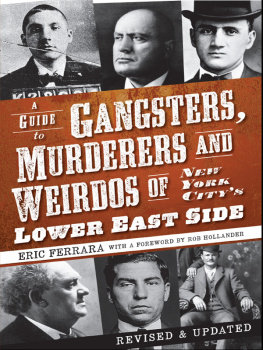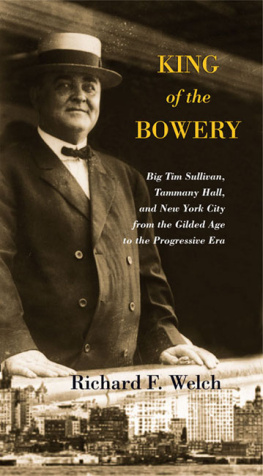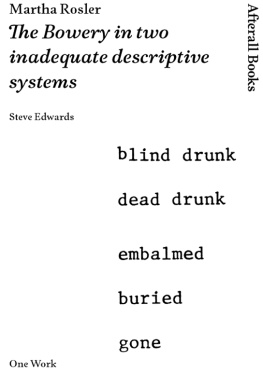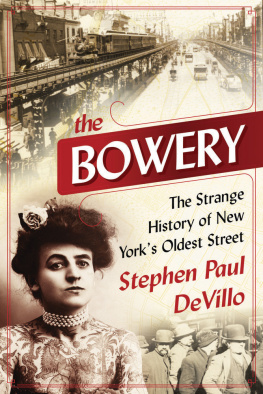The Boweryno dainty kid-glove business, but electric force and muscle.
Walt Whitman, 1888
What infinite use Dante would have made of the Bowery.
Theodore Roosevelt, 1914
Cest le quartier le plus sinistre de la ville.
(Its the most sinister neighborhood of the city.)
Albert Camus, 1946
Lets get out of here, its too literary. Lets get drunk on the Bowery
Jack Kerouac, 1960
....... THE ....................
B OWERY
A History of Grit, Graft and Grandeur
ERIC FERRARA
Published by The History Press
Charleston, SC 29403
www.historypress.net
Copyright 2011 by Eric Ferrara
All rights reserved
First published 2011
e-book edition 2011
ISBN 978.1.61423.004.5
Library of Congress Cataloging-in-Publication Data
Ferrara, Eric.
The Bowery : a history of grit, graft, and grandeur / Eric Ferrara.
p. cm.
Includes bibliographical references.
print edition: ISBN 978-1-60949-178-9
1. Bowery (New York, N.Y. : Street)--History. 2. Historic sites--New York (State)--New York. 3. Street addresses--New York (State)--New York. 4. New York (N.Y.)--History. 5. New York (N.Y.)--Social life and customs. 6. New York (N.Y.)--Social conditions. 7. New York (N.Y.)--Biography.
I. Title.
F128.67.B6F47 2011
974.71--dc22
2010052259
Notice: The information in this book is true and complete to the best of our knowledge. It is offered without guarantee on the part of the author or The History Press. The author and The History Press disclaim all liability in connection with the use of this book.
All rights reserved. No part of this book may be reproduced or transmitted in any form whatsoever without prior written permission from the publisher except in the case of brief quotations embodied in critical articles and reviews.
Dedicated to my colleagues at the Lower East Side History Project
Contents
Foreword
Bums.
Bums and winos, homeless hobos, lying on the sidewalk sleeping it off, sitting up for a moments blurry wakefulness to coax the bottle upside down and drain it, as if a drop of dregs could fix a drink. Unshaven, unwashed and unashamedly unkempt, spare-a-dime panhandlers wobbling among the flophouses and dives. No stores, no churches, no movies, not even a thrift shop; no pawnshopsnothing to hock; no laundromats, no cleaners; not a barber, not a business, not a warehouse, not even a whorehouse. Just bars and Bowery bums between the lighting wholesalers and the restaurant suppliers. Skid Row. A ghost town, filled with living ghosts, and not long for the living, either. The Bowery.
F or as long as living memory, the Bowery meant bums. Up the street or down, on every block of it, thats all youd see. Nobody else seemed to go therewhy would they? There was nothing to buy, nothing to see, nothing to do. And besides, a trip to the Bowery meant being begged for a dime every three minutes, a cigarette every two, as you gingerly stepped over the bodies lying asleep along the sidewalk. It wasnt a pretty picture. Not a dangerous neighborhoodhundreds of artists lived there in cheap commercial loft space, though youd never know it on a visit; all youd see were the bums. Not dangerous, no, it was just rock bottom, like an underworld hid beneath the slums, the lost creatures that even the slum refused. At every turn, in every corner and alley, written on every Bowery forehead, every sunken eye in toothless face, abandon all hope who come here.
How does a street, lined with handsome old nineteenth-century commercial buildings, a wide thoroughfare expanded for traffic, sandwiched between a once thriving industrial zone to the west, SoHo, and to the east once a densely populated, burgeoning immigrant ghettohow does a central corridor between business and labor dry out so completely to the bottom of the barrel?
Every ghost town once had its boomtown, before the tumbleweeds rolled by. They rose up like an excited amusement park, brilliant and new and proud, attracting all and every, and all and every business, market and con man is drawn to make a killing on the gathered crowd. But few boomtowns were ever so spectacular, so varied, so busy and bright as the Bowery once was. The Bowery was no remote boomtown in a western desert; it was the boomtown amidst the biggest city in all America. It was the brazen, blazing boom of New York City.
Equally home to opera and burlesque, museums and saloons, hotels and brothels, gangsters and gays, the Bowery had catered to every taste. In the nineteenth century, it had been not only the citys theater districtwith the largest theaters in Americabut also the daytime commercial district, its nightlife district and red-light district, its center of political power through the gangsters quartered in the Bowery saloonsin short, it was the citys heartbeat.
Bowery street walls were covered with advertisements hawking every ware for the passing street parade. Business owners conceived the notion of lighting up the signs with gas lamps, the nineteenth-century predecessor of neon and Times Square light boards, decades before Times Square yet existed. The Bowery was known far and wide as Americas brightest street, brighter than the Champs-Elyses, so they said.
Unlike the severe English Puritan Protestant heritage of the rest of America, New York, with its frank mercantile legacy, enjoyed lively nightlife and theater. And like a great street of a continental European capital, the Bowery, too, boasted grand opera and trenchant theater. The German immigrants held opera at the Bowery Theater and, just across the way, the Bowery Amphitheater. The Irish, always highly politicized, staged melodramas with the strapping Irish hero foiling the villain, unmistakably dressed as the Protestant eliteblack top hat, slender black suit and dark coat or cloakthe Protestant overlord who owned the city, who owned industry, who underpaid his Irish labor and preyed on the Irish women thrown on the streets, selling themselves to feed their kids and meet the exorbitant rents demanded by the same slender black-suited Protestant landlords. Theater was integral to the citys self-identity, and the Bowery flaunted its social character in high relief through its spectacles and drama. The Bowery loudly voiced the swelling ranks at the broad foundational bottom of industrial muscle, the driving engine of the new city and the new country.
It all began with a modest Native American footpath and a little village of farms.
When the Dutch set up their outpost of the West India CompanyNew Amsterdam was not a colony of Dutch sovereignty but merely a company trading postthey found a trail extending from the southernmost shore running steadily north, looping around the taller hills, extending all the way to the other end of the island. It was a convenient and natural path, eventually widened into a wagon road. It became the site of New Yorks first African village.
The Dutch were here to trade, and the big trade of the day was the slave trade. Africans had been brought to New Amsterdam within a year of the first settling in 1625. But the Dutch were liberal toward their slaves: after taking eighteen or twenty of the best years of their lives, and no doubt not caring to feed them into old age, the Dutch would afford their slaves a kind of conditional freedom. The freed could even own their own land, but their services could be demanded in emergencies, and their children would remain slaves.
Besides conditional freedom and ownership, Africans had recourse to protection as well. The Dutch, being a mercantile breed, cherished a strong juridical system. Property, contracts and business deals all require robust, sound courts and firm respect for rule of law. Moreover, the Dutch valued the freedom borne of justice, since back in the Old World they had spent one hundred years of warfare to free themselves from the Spanish Hapsburgs and the Holy Roman Empire. Freedom and tolerance made good business sense, trademark of the independent middle-class Dutch burgher. The local Africans in New Amsterdam took good advantage. Three slaves sued their owners to pay them for their work. True justice is blind: they won.
Next page
